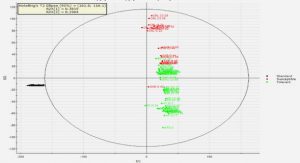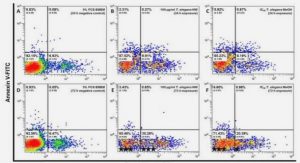Get Complete Project Material File(s) Now! »
Nonstandard nite difference schemes
In this section, we design numerical schemes that are dynamically consistent with the properties of the SIS-diusion model (3.2.2)-(3.2.6). One of the main strategies towards the construction of the schemes is that Mickens’ rule [8, 61] on the nonlocal approximation of nonlinear terms is implemented. We assume that the model (3.2.2)-(3.2.6) has a space variable x on a bounded interval [0; b] for b 2 R and a time variable t 2 [0;1). Let 4x = b=N be the space step size for a positive integer N and 4t be the time step size. Given a function u = u(x; t), the notation uk n means an approximation of u(x; t) at x = xn and t = tk, where xn = nx and tk = kt for n 2 f0; 1; 2; : : : ;Ng and k 2 N. To conclude this chapter, we consider some numerical experiments. In all these simu- lations, we take the values K = 100; = 0:2 and = 0:2 so that is the parameter that makes R0 varies. If = 1:24, then R0 = 3:1 and R0 = 0:6 when = 0:24. For dierent initial data, the excellent performance of the rst scheme (3.4.1)-(3.4.2) and the second scheme (3.4.6)-(3.4.7) are displayed in Fig 3.3-3.6 and in Fig 3.7-3.10, respectively. By taking initial conditions N0(x) = 20 + 10 sin(2x=5) and I0(x) = 10 + 10 sin(2x=5), we illustrate the dynamical consistency of the NSFD schemes (3.4.4) and (3.4.5) with respect to positivity and boundedness, as stated in Theorem 3.4.2 (Fig 3.11 a) and Theorem 3.4.13 (3.11 b), respectively.
Model formulation
In this section, we consider an extension of the classical SIS model into the SIS-Volterra integral equation (SIS-VIE) model. The extension is based on the paper [79]. We will elaborate on and clarify some of the concepts that are used whenever necessary. As a motivation, we reconsider the classical SIS model investigated in Chapter 2. How- ever, we consider here its mass action incidence formulation.
Equilibrium solutions
In order to do the qualitative analysis of the integro-dierential equation (4.2.13), it is essential, by analogy with the classical SIS model (4.2.1)-(4.2.2) or (4.2.7), to rewrite (4.2.12) in such a way that the parameter that characterizes the dynamics of this system is incorporated. The said characteristic parameter is the basic reproduction number of the model. Using the formal denition of the basic reproduction number.
1 Introduction 1
2 SIS Epidemiological Model
2.1 Introduction
2.2 SIS model
2.3 Quantitative and qualitative analysis
2.4 Nonstandard nite difference schemes
2.5 Nonstandard Runge-Kutta method for SIS model
3 SIS-Diffusion Epidemiological Model 39
3.1 Introduction
3.2 SIS-diffusion model
3.3 Quantitative and qualitative analysis
3.4 Nonstandard nite difference schemes
4 SIS-Volterra Integral Equation Model 68
4.1 Introduction
4.2 Model formulation
4.3 Quantitative and qualitative analysis
4.4 Nonstandard nite difference scheme
5 Conclusion 110
Bibliography






